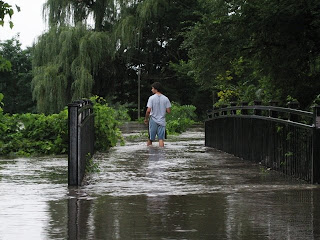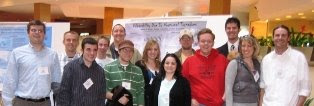History:Our Program evolved from an informal meteorological focus within the "Earth Sciences Department" (currently the Department of Geography) in the 1960s to a formal B.S. in Meteorology in 1980. We were the first meteorology or atmospheric science degree program offered by a public university in the State of Illinois and we are also among the largest in North America. Class sizes in required courses are small and personable -- averaging between 15 and 30, while enrollments in electives courses are typically smaller. In addition to regular coursework, students develop valuable preprofessional experiences through internships, undergraduate research experiences, media exposure (e.g., student run
Northern Television Center and
Northern Star), and cooperative weather directorships. Our close proximity to Chicago, Rockford, and the Quad-Cities afford our students a wealth of internship opportunities. Such experiences help our students open doors to the atmospheric science job market upon graduation. We hope to highlight these experiences through this blog in the future.
Curriculum:Meteorology is a highly structured curriculum, building on two years of mathematics and one year of calculus-based physics. The core curriculum consists of a foundation course in physical meteorology, a two-course sequence in synoptic meteorology, a two-course sequence in atmospheric dynamics, remote sensing, and additional coursework outside the department in statistics and a computer programming language. Elective courses in the weather analysis and forecasting specialization examine topics ranging from how plants, buildings and the landscape affect atmospheric processes to the mechanisms underlying large-scale severe storms, how clouds and precipitation form, and the extrapolation of weather model forecasts to local settings. Courses in the applied climatology specialization focus more on the impacts of weather and climate on human activities and the environment, understanding the geographic and temporal variability of climate, and how we can use weather and climate information to adapt our behaviors to the inherent risk and uncertainty of climate change.
NIU's B.S. degree in Meteorology meets or exceeds federal civil service requirements for employment as a meteorologist and the American Meteorological Society's
recommended curriculum.
Related Degrees:In addition to the B.S. in Meteorology, the Department of Geography offers
B.S., B.A., and minor degrees in Geography, as well as Certificates in
Geographic Information Systems (GIS) and Homeland Security. A number of our meteorology students are receiving certificates in GIS alongside their B.S. degrees. Experience and knowledge in GIS improves their marketability during the job search. For those interested in graduate work, the Department offers an
M.S. in Geography with research foci in a number of geography subdisciplines, including meteorology, climatology, and hazards.
Local AMS-NWA Student Chapter:Our students have organized a
local chapter of the American Meteorological Society and National Weather Association, where they participate in volunteer efforts as well as exciting activities such as attending conferences and visiting nearby National Weather Service offices and TV studios.
NIU Meteorology Faculty:The Meteorology Program has four full-time faculty. Those faculty include:
Dr. David Changnon
Ph.D. Colorado State University
Board of Trustees and Presidential Teaching Professor
Research and teaching emphasis in meteorology, applied climatology, hydroclimatic variability, and synoptic climatology.
Ph.D. University of Delaware
Professor
Research and teaching emphasis in dynamic meteorology, physical meteorology, surface climatology, and modeling. Ph.D. University of Georgia
Associate Professor
Met Undergraduate Coordinator
Research and teaching emphasis in synoptic and mesoscale meteorology, climatology, and atmospheric hazards. Dr. Walker Ashley
Ph.D. University of Georgia
Associate Professor
Research and teaching emphasis in mesoscale meteorology, atmospheric hazards, and GIS. The Department of Geography has nine additional faculty with specializations that blend with the atmospheric sciences, including: hydrology, societal aspects of hazards, statistics, GIS, and biogeography. You can read more about the faculty at the
Department of Geography web site.
We hope you enjoy the blog! We look forward to hearing from you.
 NIU Staff Meteorologist, Gilbert Sebenste, discusses upcoming internship opportunities with NIU Weather during the Meteorology Break-out Session.
NIU Staff Meteorologist, Gilbert Sebenste, discusses upcoming internship opportunities with NIU Weather during the Meteorology Break-out Session.



















